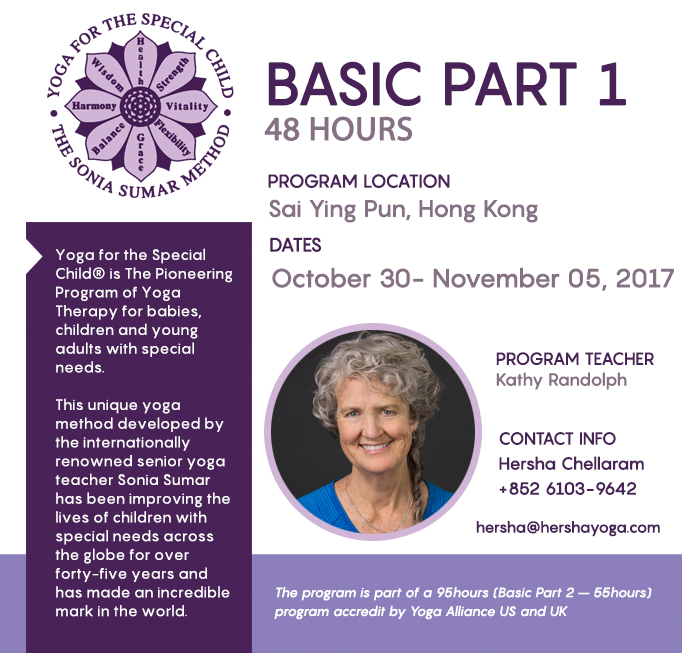Essential Lessons for Teaching Yoga to Children with Special Needs
Once I met the mother of a prospective student and she said, "I can't get my child to do a simple task like put on socks. How can I get him to do yoga?"
For many parents, the idea of yoga for their children with special needs seems impossible, even though parents are aware that yoga is effective in helping children develop better strength, mobility, coordination, gross-motor planning, improved self-regulation and confidence.
Working with children with different abilities is an honour and reward in itself, however it comes with challenges. How do we connect with kids and get them to do what we request of them?
My work over the past six years has been with children who have more profound and multiple physical and learning disabilities. I have run yoga programs in many Special Educational Needs (SEN) schools in Hong Kong for children with a range of moderate to severe physical and learning needs. In all circumstances, each child has been able to receive the benefits of what yoga has to offer. It all boils down to the approach.
Here are some of the best lessons I learned when teaching children with special needs and I am really grateful that they taught me so much.
1. Never underestimate the intelligence of a child with special needs
Whether a child is verbal or non-verbal, whether they seem to be present or not, all children understand what's going on around them. They know when a person is talking about them and they internalise the words they hear. They know exactly how you regard them based on whether you think they can or cannot hear or understand you. Children with different abilities have heightened sensitivity to energy and emotions and they can read yours like a book.
Practical Tips:
When meeting a parent or carer for the first time, do not talk about the child's disabilities. Make a special mention of all the wonderful things you notice about the child. If you need to have a conversation with a parent about particulars of a diagnosis, have this conversation away from the child, in another room or on the phone.
Speak positively about the child whenever they are in your presence, even if they are in the corner of a room engrossed in an iPad while you are talking to a parent, carer or educator. I have witnessed many children get upset when their parents talk about their child's disabilities. It also affects their attitudes towards you and the Yoga you are trying to teach them.
2. Respect a child's boundaries.
All children have boundaries regardless of ability or disability. A typical baby usually won't go to a stranger unless it feels comfortable doing so. Children with special needs are no different. Just because you are nice and respectful to them does not necessarily mean that they will warm to you immediately. This means that it will take time before they follow your directions or instructions in a yoga class. Just like you are figuring out a way to get to know them, they too are figuring out a way to get to know you. It usually takes seven meetings for a child to feel comfortable with you.
Practical Tips:
When you meet a child for the first time, introduce yourself to the parent or carer first and the child immediately afterwards. Your first priority is allowing the parent or carer to become comfortable with you, while the child evaluates you.
In the first few classes, always give a child a choice and introduce them to everything, explaining reasons why and express how good your feel after doing a pose. Make it relevant to them and their life. Even if the child watches you the whole time and does zero yoga, that's completely fine. Talk about and demonstrate the yoga poses and explain why you would want the child to move in that way, using body positive language. Always ask permission before approaching or touching the child and allow them their time to process things in their own way and own time.
3. Meet a child where they are at
One of the keys in adaptive and accessible yoga for persons with disabilities or special needs is figuring out a way for the students' bodies to experience the essence of a pose, regardless of whether they can physically get into a pose. A child with muscle spasticity needs to experience yoga quite differently from a child that as ASD/ADHD and needs to move around a lot. Wherever possible, match your energy with the child's energy when beginning the class and slowly wind them down or energise them.
Practical Tips:
When planning your class, create a simple yoga sequence that is engaging and relevant. Then adapt the postures to suit the students. In some cases, a longer class with few adaptive asanas are needed and in other instances you can have the entire lesson complete in under 10 minutes. Allow for this flexibility in your teaching.
Before teaching the class, imagine you are the child receiving the information. Putting yourself in the child's shoes works miracles in understanding how they might react to your instruction.
4. Plant seeds in every single class
Everything you do or say in the class influences the child. Children will take the lessons home with them no matter how good or bad the class experience. I once taught a boy with ASD who wasn't comfortable with me looking in his eyes. So I looked at his forehead the entire time I spoke to him. I told him that he didn't have to practice anything he wasn't comfortable doing, and he could watch from a distance. I also mentioned that he still had a responsibility to allow others to practice peacefully. Throughout the class he would jump quietly in the corner while the others practiced with me.
I would obviously mention the benefits of the poses as I taught them to the others: (e.g., "This breathing exercise helps you feel more calm when you are angry because no one understands you." or "When I put my head down in Downward Facing Dog pose, I know that it will help me when I feel overwhelmed.")
After a few weeks, I received a call from his mother who told me that he practiced yoga and meditation at home in his room when he was upset, and she was really grateful for the lessons. I never had the heart to tell the mother that this boy didn't do any yoga with me in the classroom.
Practical Tips:
Take time to study the non-physical practices of yoga, through the other branches, such as Karma Yoga, Raja Yoga, Bhakti Yoga, Japa Yoga. Find simple teachings that you can thread through your class as a one-liner. Repeat these lessons often. The children will understand and apply them at home.
Also, from a safety perspective, always teach postures that are safe for children practice at home on their own. Never teach something for one group of children while leaving the others out. You never know what they will do when they go home.
5. Communicate in positives
If someone were to tell you, "Don't think of a monkey," chances are you would think of exactly that. Same thing goes for all children. As a yoga teacher, we have the opportunities to be a very strong and positive influence for children with special needs. We can be strict but very loving to our children encouraging them to practice well. There is no benefit when you have a battle of wills in a class. Children can be very stubborn about what they want.
PRACTICAL TIPs:
After getting to know a child, you will understand the things he/she does that you definitely don't want them doing. Use a practice called Pratipaksha Bhavana -- taking a negative thought and replacing it with a positive thought -- and redirect the child's attention towards the positive thing.
Always tell them that you feel happy or that you like it when they do something well. If a child is obsessed with a toy, allow their toy to become a part of the class and to influence them to practice. Gradually shift the attention away from the toy and more to the yoga.
6. Learn through stories of others
Sometimes, the best way to work with children who have special needs is to learn from those that have spent years working with children of all abilities. Every year, I continue my studies with yoga for children with special needs because there are so many considerations and variations. No two children are the same. Learning different methods of how children can be happy and engaged in yoga, how to empower them to become their best selves is the point of all yoga practices for everyone.
PRACTICAL TIPs:
Attend the right training programs that are targeted towards children with special needs. Have conversations with members of the community about the children you work with. Learn their physical, social/emotional needs. If possible, create a network of a child's parent, teacher, therapist and other professionals.
SIGN UP FOR YOGA FOR THE SPECIAL CHILD TRAINING (DEADLINE SEPT 25)


